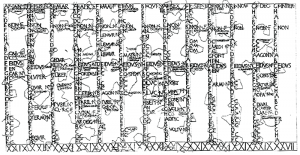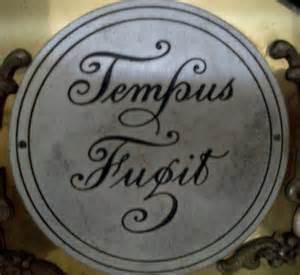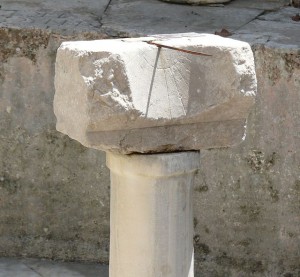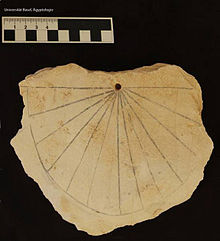Measurements of Time in Latin Posted by Brittany Britanniae on Mar 12, 2015 in Latin Language, Roman culture
Salvette Omnes,
In honor of daylight savings- and springing the clocks an hour ahead, I thought a post about Roman timekeeping was in order!
A Quarter Pass Twelve?
The Romans time of day was divided into 12 hours (Latin: horae) of light and 12 hours of darkness.
The Romans also divided the day into other periods, such as media noctis inclinatio “midnight,” gallicinium “cock-crow”, conticinium (with variants such asconticuum) “hush of the night,” and diluculum, “decline of the day. While some of theses phrases our self-explanatory, others like conticinium or asconticuum meaning “hush of the night” are a bit difficult to translate.
Although the division of hours into minutes and seconds did not occur until the middle ages, ancient astrologers had their own system for telling minutes and seconds. A minuta equal to a 60th of a day (24 modern minutes), and a secunda equal to one 3600th of a day (24 modern seconds). So, although the measurement were off- it is still pretty awesome!
What year is it?

Fasti Antiates Maiores — Miniature black and white image of a 1 m high by 2.5 m wide fragmentary fresco of a pre-Julian Roman calendar (black and red letters on a white background) found in the ruins of Nero’s villa at Antium (Anzio). Courtesy of Wikicommons.
The complicated Roman calendar (as seen above) was replaced by the Julian calendar in 45 BC by Julius Caesar. In the Julian calendar, there is an ordinary year is 365 days long and a leap year is 366 days long. So, you could say that Julius Caesar introduced the leap year!
Between 45 BC and 1 AD, leap years occurred at irregular intervals. Starting in the year 4 AD, leap years occurred regularly every four years. Year numbers were rarely used; rather, the year was specified by naming the Roman consuls for that year.
Full months were considered powerful and therefore auspicious; hollow months were unlucky. Unlike currently used dates, which are numbered sequentially from the beginning of the month, the Romans counted backwards from three fixed points: the Nones (eight days before the Ides, and fell on the fifth or seventh day of the month, ), the Ides (13th day of the months with 29 days, but the 15th day of months with 31 days)and the Kalends (first day of the month) of the following month.
How did we get our days of the week?
The Romans grouped days into an eight-day cycle called a nundina, with every eighth day being a market day.
Independent of the nundinae, astrologers kept a seven-day cycle called a hebdomada where each day corresponded to one of the seven classical planets, with the first day of the week being Saturn-day (dies Saturni), followed by Sun-day (dies Solis), Moon-day (dies Lunae), Mars-day (dies Martis), Mercury-day (dies Mercurii), Jove-day (dies Iovis), and lastly Venus-day (dies Veneris).
Although, most people can see how Saturday, Sunday, and Monday got their names-it is difficult to see how Tuesday-Friday came about. These days of the week in English actually came from Old English and Old Norse mythology. Hence, Friday is in honor of Frigg, Thursday is for Thor, Wednesday for Woden or Odin, and Tuesday is for Tyr.
However, the Romance Languages (French, Italian, Spanish) actually use the days of the week that closer resemble the Latin origins (for Tuesday-Friday)
French: Tuesday: mardi ,Wednesday: mercredi ,Thursday: jeudi,Friday: vendredi
Spanish: Tuesday: martes, Wednesday:miércoles, Thursday:jueves, Friday:viernes
Italian: Tuesday: martedì, Wednesday: mercoledi, Thursday: giovedì (Italian does not have a J in its alphabet), Friday: venerdì
Now, don’t these days of the week look closer to the Latin versions for Tuesday:Mars, Wednesday: Mercury, Thursday: Jove, and Friday: Venus?
Do you have the time?
The Romans used various timekeeping devices including the clepsydra, or water clock, and the Greek sundial.

A display of two outflow water clocks from the Ancient Agora Museum in Athens. The top is an original from the late 5th century BC. The bottom is a reconstruction of a clay original.Courtesy of Wikicommons.
A water clock or clepsydra (Greek κλέπτειν kleptein, ‘to steal’; ὕδωρ hydor, ‘water’) is any timepiece in which time is measured by the regulated flow of liquid into (inflow type) or out from (outflow type) a vessel where the amount is then measured.
The earliest sundials known from the archaeological finds are the shadow clocks (1500 BC) in ancient Egyptian astronomy and Babylonian astronomy. The ancient Greeks developed many of the principles and forms of the sundial. Sundials are believed to have been introduced into Greece by Anaximander of Miletus, c. 560 BC. According to Herodotus, the Greeks sundials were initially derived from the Babylonian counterparts. Eventually, this Greek technology found its way into the Roman Empire.

Build vocabulary, practice pronunciation, and more with Transparent Language Online. Available anytime, anywhere, on any device.
About the Author: Brittany Britanniae
Hello There! Please feel free to ask me anything about Latin Grammar, Syntax, or the Ancient World.







